7/26/2024
How to Choose the Right Particle Size Measurement Techniques
Particle size measurement is used in a wide variety of industries, for example in chemical industries, pharmaceuticals, and food and beverage.

Share this article
It’s important to determine particle size as this has a significant effect on the function and properties of products.
Particle size measurement techniques
There are a number of different techniques that can be used to measure particle size, including:
- Wet sieving
- Dry sieving
- Laser diffraction
- Light scattering
- Electrical impedance sensing
- Image analysis
How to choose a technique
You will need to consider a range of factors when choosing which method to use.
- Primarily you will need to consider the properties of the sample you’re using - such as shape, concentration, size range, and density
- Accuracy and precision requirements - for example if you are following certain regulations
- Budget and turnaround time
We have summarised the main techniques and their advantages below. Based on your specific sample and requirements.
Sieving
- Size Range - 3 μm to 10 mm
- Advantages - Simple, Inexpensive
- Limitations - Limited size range, Not suitable for fine particles, Often time-consuming
- Common industry Applications - Powders, grains, pharmaceuticals, food industry
Laser Diffraction
- Size Range - 0.1 μm to 3 mm
- Advantages - Rapid, Wide size range, Useful for particle size distribution
- Limitations - May not be suitable for irregular shapes
- Common industry Applications - Powders, slurries, sprays, pharmaceuticals, chemicals
Light scattering
- Size Range - 1 nm to 6 μm
- Advantages - High sensitivity, Ideal for very small particles
- Limitations - Complex and can be expensive
- Common industry Applications - Nanoparticles, colloids, suspensions, pharmaceuticals
Electrical impedance sensing
- Size Range - 1 μm to 1000 μm
- Advantages - Fast, online measurement, Suitable for conductive particles
- Limitations - Limited size range, Can only be used for conductive materials
- Common industry Applications - Powders, slurries, suspensions, process control
Image analysis
- Size Range - Depends on camera resolution
- Advantages - Size and shape analysis of particles
- Limitations - Time-consuming analysis and the results can be subjective
- Common industry Applications - Powders, grains, composites, catalyst characterisation
You should consider the measurement technique carefully before beginning your particle size measurement. The key priorities should be:
- Accurate Results: choose the correct technique for your size range and particle properties, otherwise it could impact quality/process control
- Efficiency: some techniques are slower and less cost-effective than others. It’s important to choose the right technique for your project based on your financial and time budgets
- Valuable information: different techniques will provide different data and selecting the correct one will ensure that you have the right data to make an informed decision about your product quality.
For more information on automating your measurement processes, contact our team.


